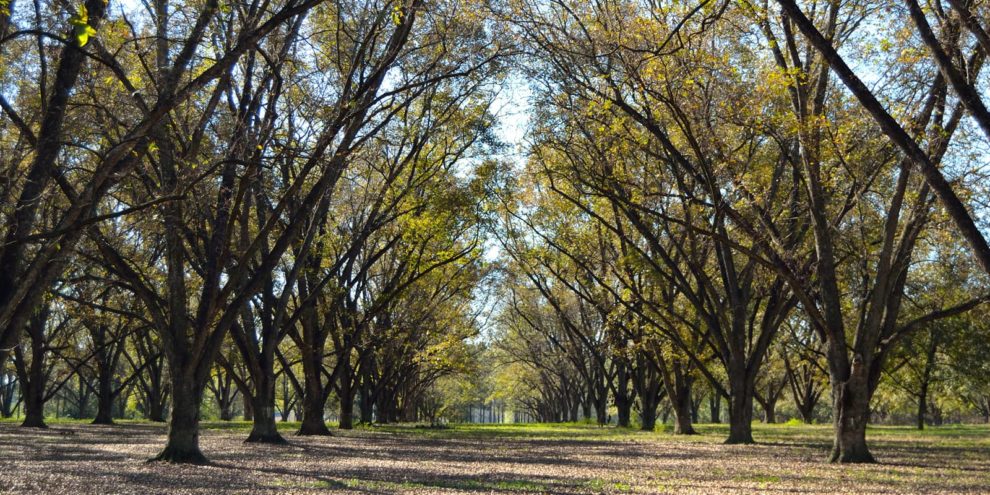Pecans are a species of hickory, and the only major tree nut that grows naturally in North America. They are considered one of the most valuable North American nut species. The word “pecan” comes from the Native American word “pacane” which means “nuts requiring a stone to crack.” As early as the 1800’s, American colonists and Native Americans were using the pecan as a means of commerce. With its buttery flavor and ease of storage, the pecan quickly gained popularity. In the late 1880’s the technique of grafting pecans was discovered; grafting ensured the grower had a consistent variety of nut which allowed growers to plant orchards.
Today the pecan industry is thriving in the southern United States. The University of Georgia Agricultural & Environmental Sciences reports that Georgia continues to be regarded as the top pecan producing state in the U.S., with over 170,000 acres planted. Pecan orchards may range in size from just a few trees to several thousand acres. The U.S. produces between 250 and 300 million pounds of pecans annually with an average farm price around $2 per pound. This puts just the farming of pecans at a half-a-billion dollar industry. This does not include the economic impact of the pecan downstream when it enters the candies, cookies, cereals, pies, and all the other goodies we consume.
As the pecan industry has evolved, so has the reach of the pecan. New varieties with better traits such as ease of cracking, better taste, and earlier ripening have been developed. In recent years, as much as 30% of the pecans produced in the U.S. have been exported. With domestic and global markets taking an interest in pecans, investors are expressing optimism that pecan investments will pay attractive dividends.
Pecans are priced high enough for consideration as a sound investment, and it has both small and large investors taking notice and looking at orchard land for sale as a long term investment.
Matthew Bailey, a south Georgia native born and raised in the heart of pecan country, is the editor of PecanReport.com, the world’s leading news organization covering the global pecan market. Pecan Report provides the latest reports and news that has to do with the current state of the pecan nuts industry.
LANDTHINK asked Matthew, who is also currently involved in the growing and exporting of pecans both in-shell and shelled, some questions about the global and domestic market for pecans, depressed prices, trade wars, and the long-term outlook for growers or investors that might be considering planting a new orchard.
Here’s what he had to say:
How does pecan production in the U.S. compare to other emerging markets/countries such as Mexico?
In quantity, Mexico is “supposedly” near the same capacity as the U.S. or maybe even a slightly larger producer. I say “supposedly” because the information received is not highly reliable.
Which state is the leading producer of pecans?
Georgia. Most of the Georgia’s pecan industry is in its southwest region. Albany and Dougherty County are known as the “pecan capital of the world,” because of the number of pecan trees in the area. Pecans are harvested during October and November, but are available year-round.
What has caused pricing to be so depressed this year?
Pecan prices have only slumped at the farm gate level; retail is booming. Large imports from Mexico, along with China sitting out of the market for 2 years due to a 47% tariff on U.S. pecans entering China, have likely caused the slump in prices at the farm gate/wholesale level.
What percentage of this year’s crop has been/will be put in cold storage?
Most of it. Each year, most of the crop goes into cold storage immediately, then gets pulled out to be shelled. The difference this year is that growers are storing more due to a slip in prices. Eventually, the crop will change hands to buyers as they work through the current inventory.
What effect will storing large quantities of pecans have on the 2021 market/prices?
If I knew the answer to that, I would be a very rich man!
Is the Chinese demand for pecans as strong as it was 3-5 years ago?
Not currently, but the “Phase One” trade deal has allowed importers to apply for a tariff reduction which, coupled with lower prices, has seen China come back to the table and start buying more this year.
Which producer do you think will ultimately get the majority of the Chinese market?
I think the U.S. will get the majority. The U.S. has been marketing more than anyone else; however, the tariffs have had a big impact on demand.
Is India a viable market to export pecans to?
Yes. There is currently a high tariff, but our council is working to have that reduced. I have written several articles about their work.
What is a long term average price a grower/investor should look to receive if considering planting a new orchard?
As we all know, historical values are no indication of the past, but the future does look very bright. To answer that question, a grower/investor should consider the market they plan to sell in. Wholesale is vastly different than retail, and costs are different as well.
Do you see some of the older varieties of pecans becoming obsolete? If so, which varieties?
Yes. Any savvy grower is replacing old varieties with new better varieties or has done so already. Again, that depends on the markets in which each grower plans to sell.
The Stuart and Desirable varieties are becoming obsolete. While there is still plenty of these varieties in and around the southeastern U.S., predominantly in Georgia, commercial growers are planting varieties that either cost less to grow or produce higher quality nuts.
The Stuart is an older variety that on average yields between 45-48% kernel. That means that for every 100 pounds of Stuart pecans produced by the grower, only 45-48 lbs of edible kernel will be produced (assuming a 0% damage or cull rate which is not realistic). We now have varieties regularly yield 55-58%. When comparing thousands of pounds over hundreds of acres, it’s a no-brainer.
As for the Desirable pecan, the input cost has become the determining factor. Desirable makes a beautiful pecan that yields above 51%, but the input cost to get it to harvest is much higher than a Kiowa or a Cape Fear, which will make just as good of a pecan with less input cost. As we put in new orchards and replace older, lower-producing orchards, we continue to upgrade to better varieties.
This content may not be used or reproduced in any manner whatsoever, in part or in whole, without written permission of LANDTHINK. Use of this content without permission is a violation of federal copyright law. The articles, posts, comments, opinions and information provided by LANDTHINK are for informational and research purposes only and DOES NOT substitute or coincide with the advice of an attorney, accountant, real estate broker or any other licensed real estate professional. LANDTHINK strongly advises visitors and readers to seek their own professional guidance and advice related to buying, investing in or selling real estate.










Add Comment